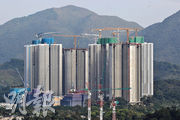Road to 5**:Waiting time for public housing averages 5.7 years
【明報專訊】The Housing Authority has announced the latest number of people waiting to be assigned public housing. As of the fourth quarter of 2020, there were more than 250,000 pending applications. The average waiting time for single general applicants and elderly applicants has risen to 5.7 years and 3.4 years respectively, both of them the highest numbers in over 21 years.
◆News summary
The Housing Authority explains that as Chun Yeung Estate at Fo Tan was used as a quarantine center and Fai Ming Estate at Fanling was vandalized, it was not possible to allocate applicants onto these estates on time. It also cites the pandemic as a reason, saying it has affected the allocation of public housing.
In recent years, private flats and public housing units have both become increasingly small in area. Chiu Kwok-wai, a member of the Housing Authority, says that due to the phenomenon of declining birth rates in Hong Kong, the number of small public housing units has increased in recent years, but it has also made it difficult for some large families with five or six people to be allocated new units.
Therefore, they can only wait for units to be returned on existing housing estates, which has increased the waiting time. He is concerned that if the number of small units continues to increase, they might encounter poor sales after converted into ''Green Form Subsidised Home Ownership Scheme'' flats, and this might even become the norm. He suggested that the Housing Authority design suitable and specific units for applicants for this scheme.
Source: Ming Pao, 10th February 2021
■Mock examination question
''The building of more public housing can help improve citizens' quality of life.'' Do you agree? Explain.
◆Agree
·Improvements to living conditions
Compared with ''subdivided flats'' whose rents are expensive and space is insufficient, public housing is much better in terms of living area, safety, and community amenities. This can alleviate the mental and physical health problems caused by overcrowding. Therefore, when it comes to improving the environment, building more public housing can improve citizens' quality of life.
·Relieving economic pressure
In recent years, rents in Hong Kong have been rocket-high. Monthly rents are lower in public housing than in subdivided flats. If more public housing can be built, the grassroots can get onto the property ladder as soon as possible to solve the problem of high rents. They can also spend more of their salaries on other everyday expenses such as medical care and transportation and improve their quality of life.
◆Disagree
·Only meeting some citizens' basic needs
Public housing is a ''safety net'' that protects the lives of grassroots and low-income families, so there are restrictions on applicants' assets and incomes. The flats have a utilitarian design just to meet the basic needs of the public, and they are far from able to enhance the quality of life of private housing. In other words, the quantitative increase will not lead to a qualitative increase. The quality of life of Hong Kong people will not be improved.
·Issues concerning living conditions of public housing
In addition to living space, good relations between neighbours, hygiene, transportation networks, amenities are all indicators of quality of life. Public housing is often associated with the issue of nuisance such as noise and littering. Whether these problems can be improved has nothing to do with the increase in the supply of public housing.
Translated by Odyssey Lang
[通通識 第698期]









